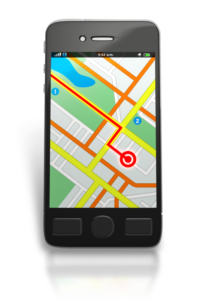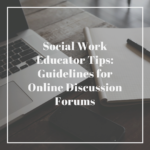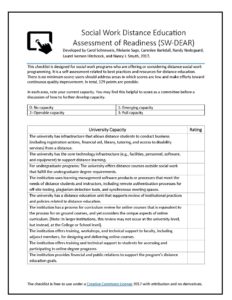Course Mapping for Online Social Work Courses
 This post was written by Denise Krause, clinical instructor at the School of Social Work at the University at Buffalo, and edited by Nancy J. Smyth, Melanie Sage, and myself. It will be included in our forthcoming book, Teaching Social Work with Digital Technology, to be published by CSWE Press in 2018.
This post was written by Denise Krause, clinical instructor at the School of Social Work at the University at Buffalo, and edited by Nancy J. Smyth, Melanie Sage, and myself. It will be included in our forthcoming book, Teaching Social Work with Digital Technology, to be published by CSWE Press in 2018.
Course mapping is considered a best practice when designing any course content for online delivery via a learning management system (LMS) (Jacobs, 2004; Quality Matters, n.d.; Wiggins & McTighe, 2005). need date; more references). It is the process of aligning the course objectives with module objectives and all learning activities in a course to create a visual overview of the course. In turn, these documents can be used to create a student roadmap, which provide clear directions on how students can navigate online course content in a consistent and methodical way. This helps to ensure that student will avoid missing instructions assignments. Roadmaps can be used in any type of online course from a web-enhanced offering to a fully online class. What goes into a student road map will vary by instructor and/or institution, but key topics include learning objectives, course content, assignments or learning tasks, and assessments.
Social Work Educator Tips: Guidelines for Online Discussion Forums

 Karen Zgoda is a social work educator, a Doctoral Student in Public Policy at the University of Massachusetts in Boston, MA, and a founding member of #MacroSW, an online community for macro social workers. In this blog post, she shares her tips for helping social work students learn how to be professional in online learning environments. This post is cross-listed on Karen’s blog at https://karenzgoda.org/.
Karen Zgoda is a social work educator, a Doctoral Student in Public Policy at the University of Massachusetts in Boston, MA, and a founding member of #MacroSW, an online community for macro social workers. In this blog post, she shares her tips for helping social work students learn how to be professional in online learning environments. This post is cross-listed on Karen’s blog at https://karenzgoda.org/.
Did you know that 95% of Americans own a cell phone of some kind, 7 in 10 Americans use social media, and that 89% of U.S. adults currently use the Internet? In fact, many check the most popular social media sites daily:
Despite the ubiquitous nature of technology and social media, we should not assume that social work students know the rules of online etiquette, especially online etiquette in professional settings. Students may not realize they are using casual language, making inappropriate or snarky comments, or revealing much about their personal lives they would not want their supervisors or professors to know. In fact, students are learning to regularly clean up their social media to take better care of their online reputations and their brand. If students are not sure what this means, I show a video clip from the The Ellen DeGeneres Show that highlights very effectively in 10 minutes why this can be problematic:
Social Work Distance Education Assessment of Readiness Checklist (SW-DEAR)
This post was written and edited by Nancy J. Smyth, Melanie Sage, and myself. It will be included in our forthcoming book, Teaching Social Work with Digital Technology, to be published by CSWE Press in 2018.
 Social work programs develop online social work programs in different ways – converting courses overtime until the entire curriculum is online; launching designated online cohorts; insourcing (hiring faculty to teach online); or outsourcing (hiring an outside firm to put your program online), including varying degrees of faculty autonomy in developing and teaching an online courses. Regardless of the approach, a first step in the process is assessment of a social work program’s readiness for online programming, and a reason for a struggling online program often has to do with stretched capacity. Many campus-wide issues must be considered before launching any type of fully online programming. These considerations include the ways in which online programming makes education more, or less, accessible to different populations of students, gatekeeping concerns, and implicit curriculum issues. To help social work programs consider capacity issues related to online programming, we have collaborated with the faculty members Carol Schneweis, Carenlee Barkdull, and Randy Nedegaard at the University of North Dakota’s Department of Social Work to develop the Social Work Distance Education Assessment of Readiness Checklist (SW-DEAR) which programs can use to assess readiness to launch online programming, and identify opportunities to strengthen current programming.
Social work programs develop online social work programs in different ways – converting courses overtime until the entire curriculum is online; launching designated online cohorts; insourcing (hiring faculty to teach online); or outsourcing (hiring an outside firm to put your program online), including varying degrees of faculty autonomy in developing and teaching an online courses. Regardless of the approach, a first step in the process is assessment of a social work program’s readiness for online programming, and a reason for a struggling online program often has to do with stretched capacity. Many campus-wide issues must be considered before launching any type of fully online programming. These considerations include the ways in which online programming makes education more, or less, accessible to different populations of students, gatekeeping concerns, and implicit curriculum issues. To help social work programs consider capacity issues related to online programming, we have collaborated with the faculty members Carol Schneweis, Carenlee Barkdull, and Randy Nedegaard at the University of North Dakota’s Department of Social Work to develop the Social Work Distance Education Assessment of Readiness Checklist (SW-DEAR) which programs can use to assess readiness to launch online programming, and identify opportunities to strengthen current programming.
This checklist is a self-assessment related to best practices and resources for distance education. The assessment includes 43 items that cover the following areas of capacity:
Review of Teaching & Learning in Social Work for 2017
 One of my favorite things to do at the end of the year is to read all of the “year-in-review” lists. Books, records, movies, top ten social work journal articles – it doesn’t matter what the list is about, I’ll read it. I am always curious how and why people choose to rank their favorite things from the year. This must be because I find it hard to choose a favorite book or movie when there are so many good options, and how can I exclude anything as a social worker, the profession that loves diversity and strives for inclusion. So for 2017, I offer a list for the Teaching & Learning in Social Work Blog. Not the top-ten blog posts, but the entire year. Here are the numbers:
One of my favorite things to do at the end of the year is to read all of the “year-in-review” lists. Books, records, movies, top ten social work journal articles – it doesn’t matter what the list is about, I’ll read it. I am always curious how and why people choose to rank their favorite things from the year. This must be because I find it hard to choose a favorite book or movie when there are so many good options, and how can I exclude anything as a social worker, the profession that loves diversity and strives for inclusion. So for 2017, I offer a list for the Teaching & Learning in Social Work Blog. Not the top-ten blog posts, but the entire year. Here are the numbers:
Number of Blog Posts in 2017 – My goals was to write or publish at least two posts a month, which happened more months than not:
Total Blog Posts = 25
Highest number of Blog Posts published in one month = 6 (October)
Lowest number of Blog Posts published in one month = 0 (August)
Guest Educator Posts in 2017 – Another goal I have for this blog is to provide a space for others to share their work, particularly work that does not fit into the traditional academic publication venues. For 2017, I am thrilled that eight social work educators wrote seven different blog posts about their scholarship of teaching and learning for the blog. I want to thank all of these authors for sharing their work and for all they do to educate future social workers!
Scholarship Dissemination Posts – My final goal for the year was to write more about my own scholarship by sharing content from conference presentations and any published articles. I published seven posts about national conference presentations with colleagues, and wrote about one article I had published in 2017. Clearly, I am doing more conferencing than publishing.
Below is a list of this year’s post grouped around the topics of assignments, projects, guest educator posts, and conference presentations.


